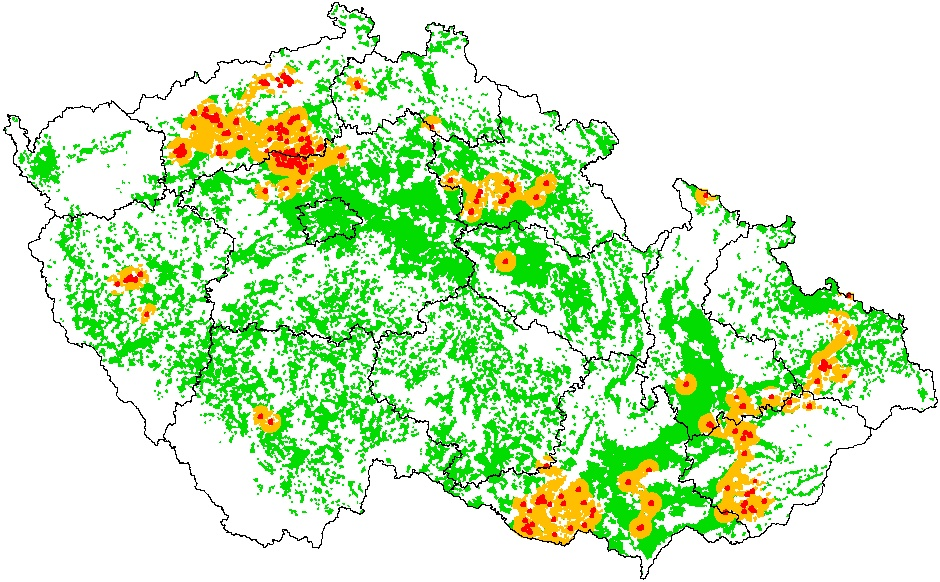Action Plan – Little Owl
Athene noctua
The formerly widespread occurrence of this tiny owl has fallen apart into isolated islands and the only larger subpopulation is now found in northwestern Bohemia. The total population size of Little Owl in the entire Czech Republic is currently estimated at just 100 – 130 pairs. This alarming situation has led to the inclusion of the Little Owl among critically endangered species in the Red list of birds of the Czech Republic. It is, at the same time, a species protected by Act No. 114/1992 Coll., as amended. Steady decline in population numbers of this owl is an issue not only in the Czech Republic, but in the whole Central Europe and other countries of our continent as well (e.g. France, the Netherlands, Slovenia, Croatia).
To ensure that this species remains part of our nature, the Nature Conservation Agency of the Czech Republic (NCA CR) initiated preparation of the Action Plan for Little Owl in the Czech Republic, which was approved by the Ministry of the Environment of the Czech Republic in 2020. The main aim of the Action Plan is to prevent the extinction of the Little Owl in our territory. More specifically, the goal is to stabilize a viable, reproducing and widespread population of the Little Owl with a positive perspective for development, and with a minimum population number of 1 000 pairs.
The Action Plan (AP) contains activities, so-called measures, which are planned in order to eliminate or mitigate the impact of factors that threaten the Little Owl. Activities leading to the removal of anthropogenic traps represent an essential measure. It includes namely searching for and securing technical traps, covering concrete electric poles, or securing risky chimneys. Another measure consists of activities aimed at eliminating shortage and unavailability of prey. Examples include appropriate mowing of grasslands, establishing grass strips, reducing the size of soil blocks, special management of arable land, limiting the use of antiparasitics or restricting pesticide application. Last but not least, measures to eliminate mortality caused by traffic and to reduce mortality on power lines and due to hitting glass surfaces are planned as well. Also an important measure of the AP focuses on ensuring sufficient supply of safe nesting sites and shelters. This means protecting existing nesting sites against predators and installing safe nesting boxes. Another measure consists of eliminating the fragmentation and isolation of populations by connecting existing centers of occurrence, which should be achieved by offering nesting sites or releasing Little Owls into well prepared, suitable habitats. In addition, measures to eliminate effects of bad weather and measures to prevent direct persecution are also part of the AP. Monitoring and mapping the occurrence of the species in the Czech Republic should reveal the success or failure of implementing the measures and bring information regarding status of the overall population. Research is also planned in specific thematic areas in order to fill in the information gaps needed for AP implementation. Another important part of the AP is public enlightenment. Involving owners or tenants of properties and lands in breeding districts of the Little Owl into the planned activities and ensuring public awareness of the AP is crucial for its successful implementation.
Implementation of the above mentioned measures within the Czech Republic is divided according to priorities into three zones: A, B, C. These zones were defined based on breeding occurrence of the species in question.
 Pic.: Zoning of the territory of the Czech Republic in terms of priorities for implementing the Action Plan measures.
Pic.: Zoning of the territory of the Czech Republic in terms of priorities for implementing the Action Plan measures.
Zone A includes existing breeding sites, that means localities with natural breeding occurrence of the Little Owl in the last 6 years (2014 – 2019) with its hunting grounds – radius up to 500 m from the nest, excluding larger water bodies and forest habitats.
Zone B is focused on potential suitable breeding sites in the surroundings of existing breeding sites and on their mutual interconnections. It is linked to zone A to the distance of 5 km from a breeding site and it further contains interconnections of breeding sites that are no more than 25 km apart, excluding water bodies and forest habitats.
Zone C represents the approximate historical range of the Little Owl during the last century. These are therefore potential areas where the Little Owl could nest again under favourable conditions. This broadest zone follows up on zone B and includes areas up to the altitude of 600 m, excluding water bodies and forest habitats.
Highest priority is given to the implementation of measures in zone A. Measures within zone B will be implemented depending on the development of population in zone A, that means with a time delay or less intensively at the beginning. In zone C, measures will be recommended, but so far not introduced in a targeted manner in the first few years of the Action Plan implementation.
